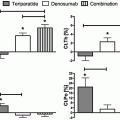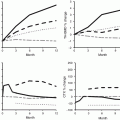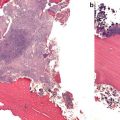© Springer International Publishing Switzerland 2016
Stuart Silverman and Bo Abrahamsen (eds.)The Duration and Safety of Osteoporosis Treatment10.1007/978-3-319-23639-1_1818. Fractures and Healing on Antiresorptive Therapy
(1)
Department of Orthopaedics, UCLA, 1250 16th St., Suite 23100, Santa Monica, CA 90404, USA
Keywords
Fracture healingBisphosphonateOsteoporosisAntiresorptiveFragility fractureDenosumabPTHAnti-sclerostin antibodyCathepsin K inhibitorEstrogenSummary
Patients with osteoporosis are more likely to suffer fragility fracture.
Medications to treat osteoporosis decrease risk of future fracture.
What is effect of osteoporosis medications on fracture healing?
No osteoporosis medications have been shown to delay fracture healing with the exception of bisphosphonates after stress fractures.
Anabolic agents (PTH, anti-sclerostin antibody) may accelerate fracture healing.
It is safe to start osteoporosis medications immediately after fracture with the exception of IV bisphosphonates, which should be started after a 2-week holiday.
New drugs are currently being studied in animal and clinical trials for their safety and efficacy.
Introduction
Fragility fracture prevention is the primary purpose of osteoporosis treatment [1]. While some patients are already taking medications for osteoporosis at the time of their fragility fracture, many patients are first diagnosed with osteoporosis after a fragility fracture . One of the greatest predictors for future fragility fractures is prior fracture , and therefore it is imperative that patients be placed on medications for osteoporosis as quickly as possible after their fragility fracture [2]. There are many good treatment options available for osteoporosis, but because these medications act on bone metabolism and decrease the risk of fracture, it is reasonable to believe that their mechanism of action could also affect fracture healing. So which drugs are safe to use during fracture healing and how soon after a fracture should they be started?
In this chapter, we review the current literature surrounding osteoporosis medications and their effect on fracture healing in the osteoporotic patient . Many of the questions surrounding antiresorptive and anabolic therapies in the period immediately surrounding a fracture are still unanswered, but it is clear that these medications help to prevent the occurrence of future fractures. Therefore, it is imperative that we understand how these medications effect fracture healing, as our patients should be given the opportunity to take their medications as soon as possible once it is safe to do so. As long as the effect on fracture healing is at least neutral, these medications should be restarted or begun immediately following a fracture. If the effect on fracture healing is negative, then it must be determined how long patients must wait before their medications can be safely begun.
How Fracture Healing Occurs
The three main stages of fracture healing are (1) inflammation, (2) repair, and (3) remodeling [1]. All fractures pass through these three stages, but the mechanisms used to achieve fracture healing can vary depending upon the size of the fracture gap and the stability of the fracture. The inflammatory phase begins within the first 24 h after a new fracture. First, a hematoma emerges around the site of the fracture which carries with it hematopoietic cells including macrophages, neutrophils, and platelets. These cells each release their own hormones and growth factors that aid in attracting more cells to the region and beginning the reparative process. Later in the inflammatory phase, fibroblasts and mesenchymal cells migrate to the fracture in order to begin the formation of granulation healing tissue. Finally, osteoblasts and fibroblasts dominate as new matrix is laid down.
In the reparative phase , fracture healing can occur by one of two pathways. Primary fracture healing occurs when the two sides of a fracture are in direct contact with each other on a microscopic level, and the fracture is essentially mechanically stable. Primary bone healing in many ways resembles normal bone remodeling. Osteoclasts directly cross the fracture site with cutting cones, and osteoblasts follow, essentially remodeling away the fracture site. Healing that occurs with stress fractures is a good example of this. Most fractures heal in a way that resembles development, with endochondral bone formation. A fracture with a material gap has some micromotion, and a cartilage callus forms at the fracture site replacing the hematoma and fibrous tissue, often within the first 2 weeks after fracture. This is called the soft callus . As the cartilage gradually becomes calcified over the next few weeks, it begins to be overlaid with bone. This is called the hard callus . Finally, the entire callus is gradually remodeled to bone to complete healing. Much of this remodeling occurs via osteoblasts and osteoclasts and is governed by Wolff’s law , meaning the remodeling occurs in response to mechanical stress. This remodeling stage of fracture healing begins only a few weeks after the fracture but is sustained for many months until the fractured bone realizes its final structure.
Effect of Specific Antiresorptive Therapies on Fracture Healing
Antiresorptives
Bisphosphonates
Bisphosphonates are one of the most widely used of the osteoporosis medications. Their main mechanism of action is through the inhibition of osteoclastic activity, thereby slowing bone resorption and remodeling [2]. The interaction between bisphosphonates and fracture healing is widely studied in animal models, but there are few human studies, so clinical decision-making should still be made with care. Bisphosphonates do not appear to have a major effect on the initial phases of fracture healing, including the ability to form cartilage callus. However, bisphosphonates do effect the remodeling phases of fracture healing, both from cartilage callus to bony callus and then the final remodeling to lamellar bone. Both human and animal studies have shown that fracture healing while on bisphosphonate therapy leads to a larger callus volume, and because there is a greater quantity of cartilage present compared to the callus seen in control subjects, there is concern that it may be weaker. Biomechanical testing of this callus shows that on a microscopic level, the strength of a section of the callus is decreased compared to a similar sized section of normal callus, but macroscopically because there is a larger quantity of callus, the entire callus is biomechanically equivalent to normal callus. To date, there are no studies that show that short-term administration of bisphosphonates leads to any negative clinical results in fracture healing [3]. Below, we summarize some of th e seminal publications pertaining to particular bisphosphonates and how they affect fracture healing.
Zoledronate
Of the bisphosphonates, zoledronate is the most efficient inhibitor of osteoclastic bone resorption, making it an ideal candidate for aiding in fracture healing. Zoledronate was shown in a randomized prospective blinded study by Lyles et al. to be associated with decreased risk of fracture as well as decreased mortality following osteoporotic hip fracture surgically repaired. Those patients receiving an infusion of zoledronate within 90 days of surgery had a 35 % risk reduction of fracture in the follow-up period of the study as well as a 28 % reduction in all-cause death [4].
The role of zoledronate in fracture healing has also been studied but is not as promising as its role in reducing future fractures. In a model of fibular osteotomies in rabbits, Matos et al. demonstrated that rabbits receiving a single dose of zoledronate demonstrated increased stimulation of primary bone production, but with decreased remodeling [5]. These rabbits tre ated with zoledronate had smaller areas of callus formation at 1 week and increased trabecular bone volume, increased woven bone quantity, and decreased periosteal fibrosis when compared to control rabbits at 4 weeks. McDonald et al. showed similar findings in a rat femur fracture model with increased callus volume and delayed remodeling. This study did not demonstrate any delay in endochondral ossification, just a delay in remodeling [6].
Studies following fracture healing in humans have shown that zoledronate does not accelerate or enhance fracture healing. Patients receiving a single dose of zoledronate after osteoporotic hip fracture were shown to have a reduced risk of subsequent fracture as well as all-cause mortality, but their time to healing was not significantly reduced. Healing time was also not found to be delayed. In a study by Colon-Emeric et al. the risk of delayed union was identical between those receiving the infusion and those receiving a normal saline infusion [7]. In an article by Harding et al., patients who had high tibial osteotomies were placed in one of two groups: a single infusion of zoledronate 4 weeks after surgery or a placebo group who received an infusion of normal saline. No differences were observed between the two groups in terms of time to healing, bone mineral density (BMD), or retention of angular correction. These results were different than those seen in a previous animal model [8].
Pamidronate
Pamidronate is a bisphosphonate used primarily in the care of patients with moderate to severe osteogenesis imperfecta (OI). There are a number of studies assessing fracture healing of patients on pamidronate, but this is in a specialized population, not necessarily generalizable to those with osteoporosis. One study by Munns et al. found that pediatric patients with OI who were on pamidronate had no statistically significant difference in rates of healing of fractures but did demonstrate a delayed healing of surgical osteotomy sites [9]. A study in a similar population by Pizones et al. showed that pamidronate also did not interfere with fracture healing in pediatric OI patients [10].
While its primary use is in patients with OI, pamidronate has also been studied for its biomechanical effects on fracture healing in rats. A study by Amanat et al. of rats given an open osteotomy was divided into four arms: saline control, systemic pamidronate, and two different dosages of local pamidronate and then assessed for healing at 6 weeks. In these rats, those with the single systemic dose of pamidronate had larger volume of callus, higher bone mineral content (BMC) of callus, and 60 % greater strength than the saline control group [11]. This result, of course, is not indicative of faster healing, simple increased bony growth.
Clodronate
Studies on the bisphosphonate clodronate have also been performed. Studies of osteotomies on rats were done by Madsen et al. and demonstrated increased BMD around the fracture site for those rats taking clodronate, but they did not find any significant difference between the groups when it came to callus area, volume, strength, or stiffness [12]. Similar results were obtained in a study of osteoporotic women with distal radius fracture who were given clodronate in a paper by Adolphson et al. They found that BMD was also increased in the experimental group but interestingly that the BMD in a more proximal aspect of the injured radius was significantly reduced in those receiving the drug [13].
Alendronate
Alendronate is the most widely studied of the bisphosphonates in models of fracture healing. It has shown increased volume of callus and BMC when compared to controls in mouse models, as well as greater strength and stiffness [14].
A study of a mouse mid-shaft femoral osteotomy by Saito et al. looked at callus formation and type of bone present at 12 weeks in four groups of animals: sham surgery, ovariectomy, ovariectomy with calcitriol, and ovariectomy with alendronate. They found that those with alendronate had a larger volume of callus, increased enzymatic cross-linking, and greater strength, but had delay in converting woven bone into lamellar bone causing no new cortical shell to appear [15]. Similar to the Saito study, Lu et al. looked at ovariectomized rats which were treated with alendronate before and after osteotomy. They also found an increased volume of callus in the treated group with improved strength but with a lower density of bone and a delay of conversion from woven to lamellar bone [16].
A study by Uchiyama et al. evaluated whether early administration of alendronate slowed healing by causing a delay in conversion to cortical bone. Half of the osteoporotic patients with distal radius fractures were randomized to receive alendronate within days of surgery and half were held without the medication for 4 months following surgery and then given alendronate. There were no significant differences found between the two groups in terms of any of the endpoints assessed including time to c ortical bridging, tenderness, grip strength, or range of motion [17]. Alendronate is considered safe for administration in the period immediately following a fracture, but although it does increase callus volume, it does not lead to faster time to complete healing.
General Bisphosphonates
Some studies on fracture healing do not specify by type of bisphosphonate as they are retrospective, but they still may draw noteworthy conclusions, and we wanted to be able to share them here. Rozental et al. compared radiographic healing of distal radius fractures on those who were taking a bisphosphonate at the time of injury and those who were not. They found a statistically significant increase in time to healing of about 1 week in those on antiresorptive therapy versus those not on medical therapy [18]. While their result was statistically significant, it may not be clinically relevant.
Similar to the Uchiyama study, a paper by Gong et al. looked at elderly patients with distal radius fractures treated with locking plate fixation and assessed if there was any difference in hea ling or clinical outcomes with either early (2 weeks after surgery) or late (3 months after surgery) administration of bisphosphonates. They, too, found no differences with respect to either radiographic or clinical outcomes of healing [19]. The same result was found in a paper by Kim et al. looking at risedronate treatment after fixation of intertrochanteric femoral fractures [20]. Savaridas et al. looked at a rat model with rigid fixation of a tibial osteotomy specifically to evaluate if ibandronate administration delayed primary bone healing, the type of healing that occurs in stress fractures. The study showed more cartilaginous like tissue and undifferentiated mesenchymal tissue present in the fracture site with delayed healing in the bisphosphonate-treated animals, suggesting that bisphosphonates do delay the healing of stress fractures [21]. No randomized trials looking specifically at human healing of stress fractures with bisphosphonate administration have been published to date.
Estrogens
Estrogen has potentially favorable effects on fracture healing, being both anabolic as well as anti-catabolic. Like bisphosphonates, estrogen and selective estrogen receptor modulators (SERM) are a common medication used in the treatment of osteoporosis, and therefore studying their effects on fracture healing is imperative. Also like bisphosphonates, no studies are currently in print demonstrating negative effects on fracture healing from short-term use of estrogen or estrogen-modifying compounds [3].
Estrogen
It has been previously demonstrated that estrogen-deficient mice, primarily by way of ovariectomy, have increased osteoclastic bone resorption. Estrogen replacement, on the other hand, has reversed this effect and caused these ovariectomized mice to return to normal levels of osteoclast bone resorption [22]. A study by Beil et al. took mice and performed femoral fractures. These mice were then separated into three groups: those which received estrogen, those which were made estrogen-deficient by way of ovariectomy, and those which were left alone to heal as the control group. Those mice that had an ovariectomy were found to have impaired periosteal callus formation, a smaller area of chondrocytes, and less distinctive mineralization, as well as a thinner and more porous cortex. Those mice that received extra estrogen in the form of a continuous infusion had the opposite effect (better fracture healing, increased area of chondrocytes, more distinct mineralization, and thicker cortex) [22].
Raloxifene
Raloxifene, a SERM, has shown similar effects on bone metabolism and fracture healing as estrogen due to its role as an estrogen agonist on bone. In a retrospective database analysis by Foster et al., those osteoporotic patients receiving raloxifene had lower rates of vertebral fractures at all time points studied (1, 3, 5, and 7 years) and had lower rates of non-vertebral fractures at 1 and 5 years [23]. More recent studies have examined raloxifene’s role in fracture healing in addition to its role simply as a treatment for osteoporosis.
Stuermer et al. were the first to study the effect of raloxifene on fracture healing in a model of an osteoporotic mouse. They performed tibial metaphyseal osteotomies that were then plated with a T-type fixation device for biomechanical stability. Their mice were placed in one of four groups, namely, ovariectomy, raloxifene-treated after ovariectomy, estrogen-treated after ovariectomy, or no treatment at all after a sham operation, and subsequently were evaluated for healing of the tibial metaphyseal osteotomy. In their study, the researchers found that the fractures in both estrogen- and raloxifene-treated mice could withstand higher loads than the ovariectomized mice. In addition, raloxifene treatment was associated with significantly greater total callus formation [24].
Stay updated, free articles. Join our Telegram channel

Full access? Get Clinical Tree







